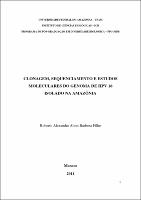| ???jsp.display-item.social.title??? |


|
Please use this identifier to cite or link to this item:
https://tede.ufam.edu.br/handle/tede/3630| ???metadata.dc.type???: | Dissertação |
| Title: | Clonagem, sequenciamento e estudos moleculares do genoma de HPV 16 isolado na Amazônia |
| ???metadata.dc.creator???: | Barbosa Filho, Roberto Alexandre Alves  |
| ???metadata.dc.contributor.advisor1???: | Astolfi Filho, Spartaco |
| ???metadata.dc.description.resumo???: | O Papillomavirus Humano é responsável por lesões na mucosa oral, anal e do trato urogenital masculino e feminino, transmitidas por contato direto ou indireto com a pele infectada ou através de relações sexuais. Na mulher essas infecções podem evoluir para um câncer de colo do útero, cuja estimativa de incidência para a região Norte no ano de 2010 foi a maior do Brasil. A natureza das infecções depende do grau de integração do DNA viral com o DNA do hospedeiro associada, principalmente, aos genes das oncoproteínas E6 e E7 do HPV. A determinação dos tipos virais pode ser realizada a partir de diferenças no gene L1 do capsídeo viral e as variantes de um determinado tipo de HPV podem ser identificadas por meio do estudo da Região Não Codificadora viral. Atualmente o desenvolvimento de vacinas profiláticas contra o HPV utiliza partículas pseudo-virais formadas pela proteína L1 de tipos virais de alto risco, enquanto cresce o número de estudos que utilizam as oncoproteínas E6 e E7 no desenvolvimento de vacinas terapêuticas. Contudo, é necessário que o desenvolvimento de tais vacinas antivirais também considere a grande diversidade das variantes dos tipos de HPV existentes, uma vez que diferenças entre as regiões genômicas dessas variantes podem influenciar o grau de suas infecções. Este trabalho descreve o sequenciamento completo do genoma de uma variante do HPV 16, detectado no Estado do Amazonas, utilizando técnicas de Engenharia Genética, bem como a análise desse genoma por ferramentas de Bioinformática. Observou-se, pela análise de distâncias genéticas, que o genoma dessa variante apresenta grande proximidade genética dos exemplares identificados na literatura como variantes africanas , e as análises filogenéticas, realizadas a partir da Região Não Codificadora, reforçam essa hipótese. Além disso, também foram detectadas várias mutações ao longo do genoma obtido, resultando em alterações nas posições e na quantidade de sítios de restrição de sua sequência. As maiores diferenças entre as regiões gênicas do genoma sequenciado e as correspondentes nas variantes africanas foram observadas ao longo de E7. Espera-se, com esse trabalho, atentar os futuros projetos de pesquisa que envolvam expressão de proteínas e análises genômicas de HPV na região amazônica para as peculiaridades existentes nas variantes regionais e fornecer uma referência concisa e completa sobre o genoma do HPV 16 na região. |
| Abstract: | The Human papillomavirus is responsible for lesions in the oral mucosa, anal and urogenital tract of male and female, transmitted by direct or indirect contact with infected skin or through sexual intercourse. In women these infections can progress to cervical cancer, which is estimated incidence for the Northern region in 2010 was the largest in Brazil. The nature of the infection depends on the degree of integration of viral DNA with host DNA linked primarily to genes of oncoproteins E6 and E7 of HPV. The determination of the viral types can be held from differences in the viral capsid L1 gene and the variants of a particular type of HPV can be identified through the study of viral non-coding region. Currently the development of prophylactic vaccines against HPV particles using "pseudo-viral" formed by the L1 protein of different subtypes of high risk, while a growing number of studies that use the oncoproteins E6 and E7 in the development of therapeutic vaccines. However, it is necessary for the development of such antiviral vaccines also consider the great diversity of variants of HPV types exist, since differences between the genomic regions of these variants may influence the degree of their infections. This paper describes the complete genome sequence of a variant of HPV 16, detected in Amazonian region, using techniques of genetic engineering and the analysis of this genome by bioinformatics tools. It was observed by analysis of genetic distance that the genome of this variant has a genetic proximity of those identified in the literature as "African variants, and phylogenetic analysis, performed from the non-coding region, support this hypothesis. In addition, several mutations were detected in the genome and obtained, resulting in changes in the positions and number of restriction sites in its sequence. The major differences between the genetic regions of the genome sequenced and the corresponding variants in Africa have been observed over E7. It is expected, with that work, look for future research projects involving protein expression and genomic analysis of HPV in the Amazon region to the regional peculiarities in variants and provide a concise and complete reference on the genome of HPV 16 in the region. |
| Keywords: | Diversidade genética Variantes de HPV 16 Amazonas Genoma viral Genetic diversity HPV 16 variants Amazonian region Viral genome |
| ???metadata.dc.subject.cnpq???: | CIÊNCIAS BIOLÓGICAS |
| Language: | por |
| ???metadata.dc.publisher.country???: | BR |
| Publisher: | Universidade Federal do Amazonas |
| ???metadata.dc.publisher.initials???: | UFAM |
| ???metadata.dc.publisher.department???: | Instituto de Ciências Biológicas |
| ???metadata.dc.publisher.program???: | Programa de Pós-graduação em Diversidade Biológica |
| Citation: | BARBOSA FILHO, Roberto Alexandre Alves. Clonagem, sequenciamento e estudos moleculares do genoma de HPV 16 isolado na Amazônia. 2010. 90 f. Dissertação (Mestrado em Diversidade Biológica) - Universidade Federal do Amazonas, Manaus, 2010. |
| ???metadata.dc.rights???: | Acesso Aberto |
| URI: | http://tede.ufam.edu.br/handle/tede/3630 |
| Issue Date: | 3-Aug-2010 |
| Appears in Collections: | Mestrado em Diversidade Biológica |
Files in This Item:
| File | Description | Size | Format | |
|---|---|---|---|---|
| Roberto Alexandre Alves Barbosa Filho.pdf | Dissertação | 1.81 MB | Adobe PDF |  Download/Open Preview |
Items in DSpace are protected by copyright, with all rights reserved, unless otherwise indicated.




